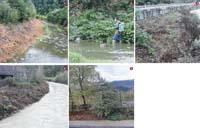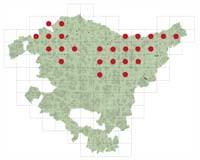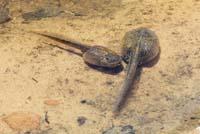Lordship of Ribera

Fallopia japonica is native to Japan, Korea and China. It began to be used in Great Britain in 1985 as an ornamental plant and from there spread to the north and center of Europe and to North America. The IUCN (International Union for Conservation of Nature) has classified the 100 most painful invasive alien species in the world as one of the twenty most invasive alien species in Spain (GEIB-Group Specializing in Biological Invasions). F. japonica likes its humid climate, its cold and its rainy summers. Therefore, in Spain, it is only a serious problem on the Cantabrian side.
Fallopia spreads very quickly. In fact, the smaller parts of the plant can also be the beginning of a new plant. Experts believe the expansion began on a single plant. Clones developed from their parts, all of the same sex. Therefore, the plant had no capacity for sexual reproduction.
Although asexual reproduction was so simple, at first it did not give problems. However, years later, the species Fallopia sachalinensis of the same genus was brought to Europe - both male and female plants. The two Fallopia species were hybridized and Fallopia japonica achieved sexual reproduction capacity. Since then, the extent of the species has increased considerably, since, by reaching sexual reproduction, the genetic variability of the species has increased, which has reinforced the species.
Wide dissemination
F. japonica can be found in all major rivers of central Europe. He likes wet and cold places. It is located mainly in the CAPV, Bizkaia and Gipuzkoa, in the rivers Ibaizabal, Gobelas, Deba, Urola and Oria. And to a lesser extent, the Cadagua and Nervión rivers are also spreading very quickly.
It generates very dense populations on the banks of the rivers. The branches and leaves form a dense net that makes everything below the plants shade. This prevents the growth of other species, as emerging young plants do not receive light. Although in winter the aerea part of the plant dies --rhizome and root survive -, they rot very slowly. Thus, even though in the winter months there is no vegetation, the layer of leaf litter is very thick and under it nothing grows. Therefore, in areas where F. japonica is stabilized no species grows. This prevents the regeneration of the natural forests of the banks.

But some hinder the growth of F. japonica: trees. F. japonica does not like shade and it is difficult to get out where it does not receive sunlight. Therefore, it rarely grows under trees.
But unfortunately, on all the banks of the river there are not enough trees to prevent the growth of Fallopia, and always find a place to start expanding. Once the right place is located, its growth is very fast --in spring there have been growths of 8 centimeters per day- and reaches heights of 2-3 meters.
The growth and expansion of this plant is not only spectacular in itself, but has been greatly favored by human action, taking advantage of all the alterations of natural ecosystems. With the construction of lanes and canalizations in the rivers, Fallopia has stabilized in all the lands that have been left without vegetation. In Gipuzkoa, despite the fact that the rain, the flow of the rivers, the type of terrain, etc., make the margins of the rivers have a fairly high regeneration capacity, if Fallopia discovers some terrain, it is finished.
Fallopia removal jobs
In view of the expansion of F. japonica in Gipuzkoa, the Council has developed a plan against it. For this they have tried a first experience in the river Urola (Azpeitia and Azkoitia). This experience has sought the most appropriate treatment.
After analyzing different alternatives, a mixed treatment has been chosen, in which in addition to cutting the plant, a chemical treatment is used. Given that they have to work on the banks of the rivers, a herbicide with little incidence in the environment has been chosen: glyphosate. The degradation of glyphosate is very rapid and the rules of use of herbicides do not establish safety deadlines; the treatment of a meadow with glyphosate allows animals to eat on the same day.
Once the herbicide is selected, the application is analyzed: which dose is most effective, how it is applied, at which time... After several tests, the following methodology has been applied: In May 2008, when the plants reached a height of 2-3 meters, they were cut. Between June and July the plant reappeared. In this reappearance, when the plants were one meter tall, they were treated with glyphosate. In October, when nobody expected it, some plants of Fallopia appeared again, about a third of the initial plants. Therefore, in mid-October the plants were treated for the second time with glyphosate.

To finish the treatment, in late autumn, when the aerial part of the plant disappears, trees were planted. They provide shade, so Fallopia does not get sunlight and the chances of it growing again are reduced.
Auxiliary plant physiology
To mark the application deadlines of the herbicide, the movements of plant fluids were taken into account. When the plant is growing, food moves up in the plant - from roots to leaves -. Once Florida, however, food begins to travel the reverse path, as then begins the end of the vegetative cycle of the plant. In this way, the plant stores as many foods as possible in the roots so that the next year the plant will grow again. If the herbicide is thrown as food moves down, it reaches more to the roots and hurts the plant more.
This spring, coinciding with the reappearance of plants, will see the effectiveness of the treatment. If it is effective, they want to work on the rest of the rivers of Gipuzkoa. The first year they want to deal harshly with all the specimens of Fallopia japonica to stop the plant to the maximum and in later years propose to make reviews where necessary. Although the elimination of Fallopia japonica is considered impossible, treatment is expected to allow them to control it in the Provincial Council of Gipuzkoa.

Buletina
Bidali zure helbide elektronikoa eta jaso asteroko buletina zure sarrera-ontzian











